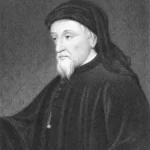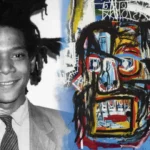Get ready for an eye-opening journey into the world of David Hockney, a painter who’s known for his bold and innovative style. We’ll go behind-the-scenes, explore his famous works, and uncover the stories behind the artist. From his quirky use of perspective to his groundbreaking collages, this is your chance to discover the secrets and surprises of one of the most influential artists of our time. So buckle up and let’s dive into the mind and art of David Hockney!
David Hockney Interesting Facts
David Hockney, the kind of artist who makes you see the world in a whole new light, is best known for his vibrant, joyful paintings. But Hockney’s talents extend far beyond the canvas. Let’s dive into some fascinating facts about this artistic legend:
A True Artistic Polyglot
Hockney moves effortlessly between mediums, much like a polyglot switches between languages. Photography, printmaking, and even stage design – he’s mastered them all, bringing his unique vision to each.
The Pop Art Connection and Beyond
Bold lines, bright colors, and everyday objects transformed into art – that’s Pop Art, and Hockney played a key role in shaping this movement. His vibrant palette and daring compositions continue to inspire contemporary artists today.
Living His Truth Through Art
Hockney’s art became a powerful outlet for his experiences as a gay man, especially during a time when societal acceptance was limited. His work not only reflects his personal journey but also helped pave the way for greater LGBTQ+ visibility in the art world.
Technophile with a Paintbrush
Despite his deep connection to color and light, Hockney embraced technology, incorporating tools like photocopiers and digital photography into his artistic process. He proved that art can evolve alongside technological advancements.
Those Iconic Swimming Pools, Though…
Those crystal-clear pools bathed in California sunshine, often featuring a lone figure enjoying a dip, have become synonymous with Hockney’s work. These paintings capture the allure of the Californian dream while exploring themes of light, water, and illusion.
A Global Art Superstar
From London to New York to Tokyo, Hockney’s work has graced renowned museums worldwide, transcending borders and captivating audiences from all walks of life. He is a true global art superstar.
From Yorkshire to the World
Born and raised in Yorkshire, England, Hockney’s journey took him from the rolling hills of his hometown to the sunny shores of California and the vibrant streets of Paris. His experiences as a global citizen are reflected in his art, showcasing his openness to diverse cultures and environments.
The Hockney Legacy
Whether a landscape, a portrait, or even an iPad drawing, Hockney’s art possesses a timeless quality that continues to resonate with audiences today. His vibrant colors, emotional depth, and exploration of the human experience solidify his undeniable impact on the art world.
The Man Behind the Art
Hockney’s personality shines through in his casual yet stylish attire, often featuring bright colors and bold patterns, much like the fearless use of color that defines his art. He reminds us that art is as much about the artist’s life and personality as it is about the work itself.
What are fun facts about David Hockney?
David Hockney, the artist famous for his bright, sunny paintings, is full of surprises. Here are some quirky and intriguing tidbits about this artistic legend:
- A Dip in the Pool, A Spark in the Mind: Hockney believes that swimming enhances his creativity and problem-solving skills. It’s as if his brain takes a refreshing dip along with his body.
- Inspired by a Master: Hockney deeply admires Pablo Picasso, seeing him as a fearless innovator who broke artistic boundaries.
- An Unconventional Habit: Hockney has stated that smoking helps him focus his mind and enhances his artistic process. While not endorsing smoking, it offers a glimpse into his unique perspective.
- From Canvas to Pages: Hockney’s fascination with swimming pools inspired his book “A Bigger Splash”, which delves into themes of love, loss, and desire.
- California Dreamin’: Hockney’s move to California in the 1960s had a profound impact on his art. The bright colors and vast landscapes of his new home are evident in his work from that period.
These fun facts provide a glimpse into the man behind the masterpieces, reminding us that even the most famous artists are full of surprises and contradictions.
Did David Hockney Have Synesthesia?
David Hockney’s experience of the world is as fascinating as his art. There’s a possibility that he had synesthesia, a condition where the senses intertwine. Specifically, he may have had chromesthesia, meaning he saw colors when he heard sounds – like a built-in light show in his mind.
While Hockney stated that synesthesia didn’t directly influence his painting, it played a significant role in his work as a stage designer. Imagine him listening to an opera and seeing a burst of crimson when the soprano hits a high note, or a wave of azure during a quiet flute solo. He used these color “visions” to guide his design choices, creating immersive theatrical experiences.
Interestingly, Hockney referred to synesthesia as both a “gift” and a “disability.” His experience reminds us that even with unique neurological wiring, individuals can transform challenges into sources of incredible creativity.
Although we cannot confirm Hockney’s synesthesia without in-depth studies, his descriptions and work, particularly his stage designs, strongly suggest its presence.
What was David Hockney most known for?
David Hockney, a prominent figure in the 1960s Pop Art movement, is perhaps best known for his vibrant, almost cartoon-like paintings of ordinary objects, particularly swimming pools.
His iconic swimming pool paintings, inspired by his move to California, capture the essence of the laid-back California lifestyle. The sunshine and splashing water practically leap off the canvas.
However, Hockney’s artistic talents extended far beyond painting. He was a master of drawing, printmaking, photography, and even stage design – a true artistic chameleon, always pushing boundaries and exploring new mediums.
Hockney’s ability to transform the mundane into iconic art, coupled with his versatile artistic spirit, solidifies his place as a true original in the art world.
Is David Hockney Deaf?
For over 40 years, David Hockney navigated the world with significant hearing loss, relying on hearing aids. However, he didn’t see his deafness as a limitation. Instead, he often spoke about how it enriched his art.
Some experts suggest that when one sense weakens, others may heighten to compensate. In Hockney’s case, his hearing loss might have intensified his visual perception, contributing to his work’s celebrated vibrant colors, bold lines, and unique perspectives.
Hockney didn’t shy away from exploring his deafness in his art, weaving it into the fabric of his paintings, drawings, and prints. This vulnerability adds a layer of authenticity to his work, allowing viewers to connect with it on a deeper level.
Hockney’s story is a testament to resilience and creativity. He embraced his deafness, viewing it as a unique perspective that informed his art and contributed to his global recognition.
Why is David Hockney unique?
David Hockney stands out in the art world because of his constant drive to push boundaries and explore new ways of expression. He never limited himself to a single style, medium, or technique.
One of his most unique qualities was his likely synesthesia, allowing him to experience colors in response to music. This sensory phenomenon directly influenced his vibrant, immersive stage designs for theater and opera.
His paintings, often blending elements of Cubism and Surrealism, are characterized by bold colors, sharp lines, and a distinctive style that is instantly recognizable. His swimming pool paintings, in particular, capture the interplay of light and water, freezing a moment in time.
But Hockney’s artistic genius extended beyond painting. He was a skilled photographer, capturing stunning landscapes and experimenting with Polaroid collages. He was also an innovator in printmaking, mixing materials and techniques to create layered, textured pieces.
Here’s a breakdown of Hockney’s unique qualities:
- Synesthesia fuels his art: His unique sensory experience translated into vibrant, immersive stage designs.
- A style all his own: His signature look combined elements of Cubism and Surrealism, rendered in bold, eye-catching colors.
- More than just pools: His swimming pool paintings went beyond mere representation, capturing the essence of light, water, and time.
- A master of many mediums: He excelled in photography and printmaking, showcasing his versatility and innovative spirit.
David Hockney’s prolific career and constant innovation continue to captivate and inspire. There’s always something new to discover in his work, solidifying his place as a true original in the art world.
How many houses does David Hockney have?
While the exact number of houses David Hockney owns remains private, we can delve into the homes that have played significant roles in his life and artistic journey.
His childhood home in Bridlington, England, undoubtedly provided a foundation of inspiration, shaping his artistic sensibilities from a young age. Later, his studios in London, where he honed his craft and launched his career, became creative havens.
However, it’s his California residences that are most often associated with his work. His Hollywood Hills home, with its iconic swimming pool, has become legendary, inspiring his vibrant pool paintings. Similarly, his Malibu beachfront property, offering breathtaking views, likely fueled his fascination with light and color.
Hockney’s homes were more than just places to live – they were extensions of his artistic vision. His “Domestic Interiors” series, for example, is believed to have been influenced by the architecture of his London studio.
While the exact number of houses he owns remains a mystery, one thing is clear – David Hockney’s homes are integral characters in the narrative of his art.
How much did David Hockney’s Portrait of an Artist sell for?
In 2018, David Hockney’s “Portrait of an Artist (Pool with Two Figures)” made headlines when it sold for a staggering $90.3 million at Christie’s in London, setting a record for the most expensive artwork sold by a living artist.
Created in 1972, the painting captures Hockney’s signature California aesthetic, featuring a man standing by a swimming pool with his back to the viewer. The vibrant colors, clean lines, and intriguing composition have captivated audiences worldwide.
But Hockney’s influence extends far beyond this single painting. His innovative spirit led him to experiment with Polaroid collages, digital art, and various other mediums, solidifying his place as a true innovator in the art world.
His impact on the art world is undeniable. He has inspired countless artists and continues to captivate audiences with his creativity and bold vision.
Why did David Hockney paint his parents?
David Hockney, while known for his vibrant landscapes and swimming pool scenes, also created compelling portraits, including the poignant “My Parents” from 1977. This seemingly simple depiction of his mother and father sitting in their living room offers a glimpse into the complexities of family relationships.
While we can never know for sure, Hockney likely painted his parents to preserve a precious memory, capturing a specific moment in time. The painting also suggests a deeper exploration of family dynamics, the bond between parent and child, and perhaps even reflections on mortality.
Whatever his reasons, “My Parents” stands as a moving testament to the enduring power of family ties, inviting viewers to contemplate their own familial relationships.
Key Takeaways:
- David Hockney, renowned for his landscapes and pool scenes, also created compelling portraits.
- “My Parents”, painted in 1977, offers a glimpse into his family dynamics and the passage of time.
- Hockney’s motivations likely included preserving a memory, exploring family ties, and expressing love for his parents.
- The painting transcends its personal context, prompting reflections on family and mortality.
What style of photography is David Hockney known for?
David Hockney’s photography wasn’t about capturing a single moment – it was about bending reality and challenging traditional perspectives. He used photography to create images that felt like collages, playing with vibrant colors, unexpected angles, and fragmented perspectives.
During the 1970s, Hockney explored photography’s ability to capture multiple viewpoints simultaneously. He created immersive installations using his photographs, surrounding viewers with his unique vision.
He embraced unconventional methods, utilizing Polaroid cameras and photocopiers to distort and reshape images. His Polaroid collages, composed of numerous shots, offer a kaleidoscopic view of a single moment, pulling viewers into his way of seeing.
Hockney also blurred the lines between photography and painting, incorporating photographic elements into his canvases. His work challenged viewers to reconsider how we see, remember, and create images.
His experimental spirit continues to inspire artists today, pushing the boundaries of photography and leaving an undeniable mark on the art world.
Why did Hockney paint Portrait of an Artist?
David Hockney’s “Portrait of an Artist (Pool with Two Figures)” offers a glimpse into the artist’s psyche and the complexities of human relationships. While the exact meaning remains open to interpretation, we can glean insights from the painting itself and Hockney’s life at the time.
Swimming pools were more than just backdrops for Hockney; they were stages for exploring relationships and the feeling of isolation. The two figures in the painting, while sharing the same pool, seem worlds apart, hinting at an underlying tension.
Some art historians believe the painting reflects Hockney’s personal life, particularly a tumultuous period in his relationship with his then-boyfriend. The figures’ positioning – one submerged, the other observing – suggests a sense of heartache and longing.
However, Hockney’s art also captured the zeitgeist of the late 60s and early 70s. The painting’s vibrant colors, clean lines, and idyllic setting evoke a sense of “California dreamin’,” while a subtle sadness lurks beneath the surface, hinting at the complexities beneath the glamour.
Ultimately, “Portrait of an Artist” is a multifaceted work that invites viewers to contemplate its various interpretations. It might be about heartbreak, the loneliness of fame, or the fleeting nature of beauty.
Key Points about David Hockney
- Artistic versatility: Masters multiple mediums, including painting, photography, printmaking, and stage design.
- Pop Art influence: Contributed to the Pop Art movement with vibrant colors and bold compositions, inspiring contemporary artists.
- Personal expression: Embraced his gay identity in his art, promoting LGBTQ+ visibility.
- Technological embrace: Incorporated photocopiers and digital photography into his process, demonstrating the compatibility of art and technology.
- Iconic swimming pools: Known for his crystal-clear pool paintings that capture California’s allure and explore optical illusions.
- Global recognition: Works exhibited in prestigious museums worldwide, establishing his status as an international art superstar.
- Diverse influences: Traveled extensively, absorbing cultural experiences that influenced his art.
- Timeless appeal: His work transcends eras, connecting with audiences through its emotional depth and profound exploration of humanity.
- Personal charm: Known for his stylish and colorful attire, which reflects his artistic boldness.
Key Lines:
- David Hockney, born in 1937, is one of the most renowned contemporary British artists known for his contributions to pop art.
- Hockney’s distinctive style reflects influences from Cubism, Surrealism, and his fascination with swimming pools and California landscapes.
- Despite declining a knighthood, Hockney received recognition with the Order of Merit in 2012 and was voted the most influential British artist of all time in 2011.
- Hockney’s daily swimming routine and belief in smoking’s mental health benefits highlight his eccentric and unconventional nature.
Uncover fascinating insights about renowned author Mitch Albom by exploring 10 facts about him. Immerse yourself in the captivating world of Laura Ingalls Wilder as you delve into 16 true facts and journey through her extraordinary life and adventures.
- Unlock Water’s Symbolism: A Cross-Cultural Exploration - April 20, 2025
- Identify Black and White Snakes: Venomous or Harmless? - April 20, 2025
- Unlocking Potential: Origins High School’s NYC Story - April 20, 2025















